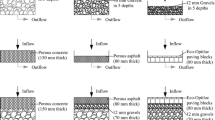Abstract
Aircraft and pavement deicing formulations and other potential freezing point depressants were tested for biochemical oxygen demand (BOD) and chemical oxygen demand (COD). Propylene glycol-based aircraft deicers exhibited greater BOD5 than ethylene glycol-based aircraft deicers, and ethylene glycol-based products had lower degradation rates than propylene glycol-based products. Sodium formate pavement deicers had lower COD than acetate-based pavement deicers. The BOD and COD results for acetate-based pavement deicers (PDMs) were consistently lower than those for aircraft deicers, but degradation rates were greater in the acetate-based PDM than in aircraft deicers. In a 40-day testing of aircraft and pavement deicers, BOD results at 20°C (standard) were consistently greater than the results from 5°C (low) tests. The degree of difference between standard and low temperature BOD results varied among tested products. Freshwater BOD test results were not substantially different from marine water tests at 20°C, but glycols degraded slower in marine water than in fresh water for low temperature tests. Acetate-based products had greater percentage degradation than glycols at both temperatures. An additive component of the sodium formate pavement deicer exhibited toxicity to the microorganisms, so BOD testing did not work properly for this formulation. BOD testing of alternative freezing point depressants worked well for some, there was little response for some, and for others there was a lag in response while microorganisms acclimated to the freezing point depressant as a food source. Where the traditional BOD5 test performed adequately, values ranged from 251 to 1,580 g/kg. Where the modified test performed adequately, values of BOD28 ranged from 242 to 1,540 g/kg.



Similar content being viewed by others
References
Airport Cooperative Research Program (2009). Formulations for aircraft and airfield deicing and anti-icing: Aquatic toxicity and biochemical oxygen demand. Washington: Airport Cooperative Research Program, Transportation Research Board of the National Academies. [online] http://onlinepubs.trb.org/onlinepubs/acrp/acrp_webdoc_003.pdf.
Airport Cooperative Research Program (2010). Alternative aircraft anti-icing formulations with reduced aquatic toxicity and biochemical oxygen demand. Washington: Airport Cooperative Research Program, Transportation Research Board of the National Academies. [online] http://onlinepubs.trb.org/onlinepubs/acrp/acrp_webdoc_008.pdf.
American Public Health Association, American Water Works Association, and Water Environment Federation. (1995). Standard methods for the examination of water and wastewater. Washington: American Public Health Association.
American Public Health Association, American Water Works Association, and Water Environment Federation. (2005). Standard methods for the examination of water and wastewater. Washington: American Public Health Association.
American Society for Testing and Materials International. (1993). Annual book of ASTM standards: Water and environmental technology. Philadelphia: American Society for Testing and Materials International.
Cornell, J. S., Pillard, D. A., & Hernandez, M. T. (2000). Comparative measures of the toxicity of component chemicals in aircraft deicing fluid. Environmental Toxicology and Chemistry, 19(6), 1465–1472.
Corsi, S. R., Booth, N. L., & Hall, D. W. (2001). Aircraft and runway deicers at General Mitchell International Airport, Milwaukee, Wisconsin, USA. 1. Biochemical oxygen demand and dissolved oxygen in receiving streams. Environmental Toxicology and Chemistry, 20(7), 1474–1482.
U.S. Environmental Protection Agency (2000). Preliminary data summary: Airport deicing operations (revised). Washington: EPA. [online] http://www.epa.gov/waterscience/guide/airport/.
Jaesche, P., Totsche, K. U., & Kogel-Knabner, I. (2006). Transport and anaerobic biodegradation of propylene glycol in gravel-rich soil materials. Journal of Contaminant Hydrology, 85(3–4), 271–286.
Klecka, G. M., Carpenter, C. L., & Landenberger, B. D. (1993). Biodegradation of aircraft deicing fluids in soil at low temperatures. Ecotoxicology and Environmental Safety, 25(3), 280–295.
Koryak, M., Stafford, L. J., Reilly, R. J., Hoskin, R. H., & Haberman, M. H. (1998). The impact of airport deicing runoff on water quality and aquatic life in a Pennsylvania stream. Journal of Freshwater Ecology, 13(3), 287–298.
Revitt, D. M., & Worrall, P. (2003). Low temperature biodegradation of airport de-icing fluids. Water Science and Technology: A Journal of the International Association on Water Pollution Research, 48(9), 103–111.
Schulz, M., & Comerton, L. J. (1974). Effect of aircraft deicer on airport storm runoff. Journal of the Water Pollution Control Federation, 46(1), 173–180.
Stover, E. L., & McCartney, D. E. (1984). BOD results that are believable. Water Engineering and Management, 131(4), 37–40, 62, 66.
Streeter, H. W., & Phelps, E. B. (1925). A study of the pollution and natural purification of the Ohio river. Washington: U.S. Public Health Service.
Vaishnav, D. D., & Korthals, E. T. (1988). Comparison of chemical biodegradation rates in BOD dilution and natural waters. Bulletin of Environmental Contamination and Toxicology, 41(2), 291–298.
Acknowledgments
Support for this research was provided by the Airport Cooperative Research Program. We thank Kevin Joback of Molecular Knowledge Systems, Harris Gold of Infoscietex Corporation, Graham Anderson, Anthony Plourde, Susan Hill, Michael Manix, Steven Geis, Sharon Kluender, and Sharon Long of the Wisconsin State Laboratory of Hygiene, and Lee Ferguson of Duke University for technical input and laboratory analytical work. Any use of trade, product, or firm names is for descriptive purposes only and does not imply endorsement by the U.S. Government.
Author information
Authors and Affiliations
Corresponding author
Electronic supplementary material
Below is the link to the electronic supplementary material.
ESM 1
(PDF 285 kb)
Rights and permissions
About this article
Cite this article
Corsi, S.R., Mericas, D. & Bowman, G.T. Oxygen Demand of Aircraft and Airfield Pavement Deicers and Alternative Freezing Point Depressants. Water Air Soil Pollut 223, 2447–2461 (2012). https://doi.org/10.1007/s11270-011-1036-x
Received:
Accepted:
Published:
Issue Date:
DOI: https://doi.org/10.1007/s11270-011-1036-x




